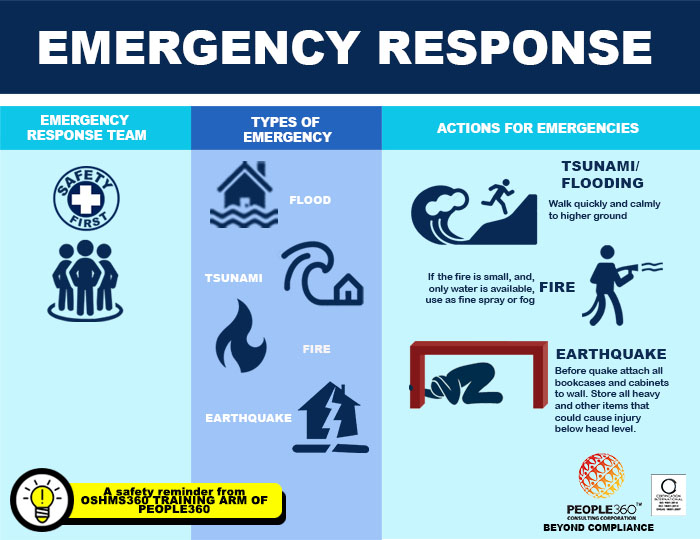Emergency Response
Emergency situations warranting a response can range from natural disasters to hazardous materials problems and transportation incidents. Emergency response plans are a critical component of workplace safety. Response time is an important aspect of emergency response.

EMERGENCY
is an unforeseen event that requires an immediate action from trained personnel, i.e. Fire Brigade, Medical, Evacuation and Maintenance Crew.
EMERGENCY RESPONSE TEAM (ERT)
- is a structured group whose function is to control an emergency or disaster.
- is composed of the following senior personnel and other emergency groups.
Types of Emergency
Earthquake
a sudden and violent shaking of the ground, sometimes causing great destruction, as a result of movements within the earth's crust or volcanic action.

Tsunami
A tsunami can kill or injure people and damage or destroy buildings and infrastructure as waves come in and go out. A tsunami is a series of enormous ocean waves caused by earthquakes, underwater landslides, volcanic eruptions, or asteroids. Tsunamis can:
- Travel 20-30 miles per hour with waves 10-100 feet high.
- Cause flooding and disrupt transportation, power, communications, and the water supply.
- Happen anywhere along U.S. coasts. Coasts that border the Pacific Ocean or Caribbean have the greatest risk.

Fire
Of all the natural disasters, fire is the only one that is both beneficial to man and his environment as well as destructive and deadly. Outdoors will be your forest fires or wildfires. Indoors will be building fires and house fires. Fires need three things if they are going to continue to burn: Oxygen, heat and fuel.

Flood
is an overflow of water that submerges land that is usually dry. Floods can also occur in rivers when the flow rate exceeds the capacity of the river channel, particularly at bends or meanders in the waterway. Floods often cause damage to homes and businesses if they are in the natural flood plains of rivers.

Actions for Emergencies:
Outline:
- Plan step-by-step procedures according to each possible emergency: Fire, spill or leak, transport accident, etc.
- Designate responsible personnel beforehand
- Write down everything that happens!
- Share the outline with local responders
FIRE
If the fire is small:
- Contain with fog, foam, or dry powder
- If only water is available:
- use as fine spray or fog, don’t over-wet
- Caution: water jets can break bags, glass, may spread contamination
- Contain the water and spilled chemicals
If the fire is large:
- Consider withdrawing and letting it burn -- using water may lead to widespread contamination
- Build dikes to contain water if necessary
After the fire:
- Clean or dispose of all clothing
- Everyone involved should shower
- Do not clean up or salvage until area has cooled
EARTHQUAKE
Before quake attach all bookcases and cabinets to wall.
Store all heavy and other items that could cause injury below head level.
When shaking begins, if inside:
- Stay away from windows and get under desk or table.
- Drop, cover, and hold on.
- In hallway, sit against wall and protect your head with your arms.
- In auditorium, duck between rows and protect your head.
- Take cover until shaking stops, then evacuate to Emergency Assembly Point.
TSUNAMI/FLOODING
- Walk quickly and calmly to higher ground
- Stay away from beaches
- Most tsunamis are from earthquakes far out at sea, so there will be time to evacuate
- If there is a strong local earthquake a tsunami could arrive in minutes
- Don’t wait. Get to high ground
Source:
https://www.google.com/search?rlz=1C1GCEB_enPH844PH844&q=Dictionary
https://www.google.com/search?rlz=1C1GCEB_enPH844PH844&ei=ls4RXbbUA5XmwQOwtpq4AQ&q=earthquake


